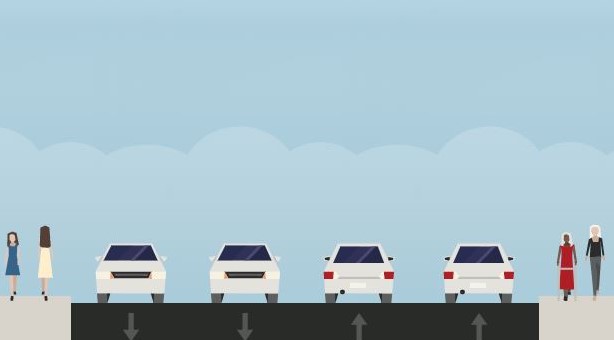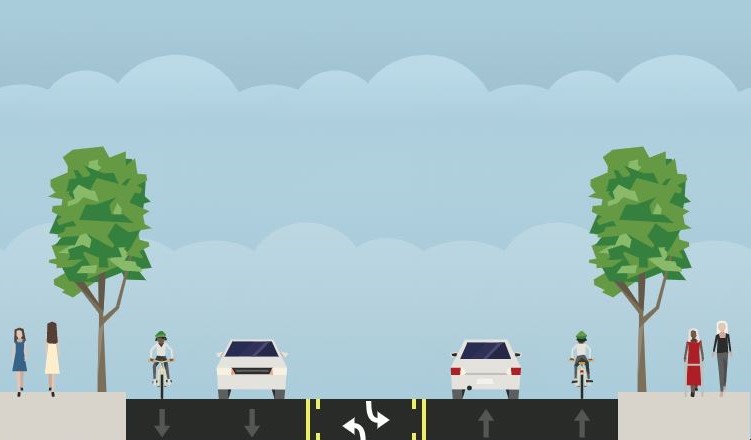ROAD RIGHT-SIZING
Creating Safe Streets for Everyone
Right-sizing a road involves repurposing road travel lanes from car-only travel to other uses such as bicycle lanes or on-street parking. Right-sizing happens on streets that are deemed to be inefficiently and unsafely oversized. Oversized streets tend to create many negative impacts, such as cars traveling at excessive, dangerous speeds. Right-sizing creates “Complete Streets” that can be used for all forms of travel – bicycling, walking, transit, and motor vehicle travel.
Right sizing streets for people emphasizes the need to balance traffic engineering with urban design to create streets that function well for all users of the corridor.
Our streets must work as a network of passageways that collectively serve the needs of the local community including daily commuting, economic and commercial activities, deliveries, special events, and much more.
Rightsizing a street is often a prerequisite to the street becoming a place where people want to be, instead of just a corridor to pass through. Rightsizing reconfigures a street to best serve the people who need to use it, whether they’re drivers, pedestrians, or bicyclists. By improving safety, especially for people walking or biking, and by increasing space devoted to people, rightsizing projects cause vehicles to slow down and people to spend more time outside on the street. This is great for people who live in the street’s vicinity, businesses that line it, and those who travel through it.
Example of Road Right-Sizing

Previous roadway configuration

New roadway configuration
Streets should be safe, comfortable, and convenient for travel for everyone, regardless of age or ability – motorists, pedestrians, bicyclists, and public
transportation riders.
Right-Sizing a Road Can Benefit Communities
-
-
-
-
-
-
- Decrease crashes
- Improve safety
- Economic growth
- Increase capacity
- Improve health and wellbeing
-
-
-
-
-
- Reduce costs
- Smarter growth
- Provide choices
- Lower emissions
Road Diets reduce vehicle-to-vehicle conflicts that contribute to rear-end, left-turn, and sideswipe crashes by removing the four-lane undivided inside lanes serving both through and turning traffic. Studies indicate a 19 to 47 percent reduction in overall crashes when a Road Diet is installed on a previously four-lane undivided facility as well as a decrease in crashes involving drivers under 35 years of age and over 65 years of age.1, 2
Road Diets improve safety by reducing the speed differential. On a four-lane undivided road, vehicle speeds can vary between travel lanes, and drivers frequently slow or change lanes due to slower or stopped vehicles (e.g., vehicles stopped in the left lane waiting to turn left). Drivers may also weave in and out of the traffic lanes at high speeds. In contrast, on three-lane roads with TWLTLs the vehicle speed differential is limited by the speed of the lead vehicle in the through lane, and through vehicles are separated from left-turning vehicles. Thus, Road Diets can reduce the vehicle speed differential and vehicle interactions, which can reduce the number and severity of vehicle-to-vehicle crashes. Reducing operating speed decreases crash severity when crashes do occur.
Road Diets can be of particular benefit to nonmotorized road users. They reallocate space from travel lanes– space that is often converted to bike lanes or in some cases sidewalks, where these facilities were lacking previously. These new facilities have a tremendous impact on the mobility and safety of bicyclists and pedestrians as they fill in a gap in the existing network. Even the most basic Road Diet has benefits for pedestrians and bicyclists, regardless of whether specific facilities are provided for these modes. As mentioned above, the speed reductions that are associated with Road Diets lead to fewer and less severe crashes. The three-lane cross-section also makes crossing the roadway easier for pedestrians, as they have one fewer travel lanes to cross and are exposed to moving traffic for a shorter period of time.
More Information
For information about the safety improvements, benefits of the roadway configuration change, and feedback we have received about the corridor, please see the following resources:
- E. Martin Luther King Blvd. and Bailey Ave. Project Report
- Federal Highway Administration Road Diet Informational Guide
- National Association of City Transportation Officials Urban Street Design Guide
- Institute of Transportation Engineers - Designing Walkable Urban Thoroughfares: A Context Sensitive Approach
- Project for Public Spaces Technical Guidance on Road Diets
- Project for Public Spaces Rightsizing Streets Guide

